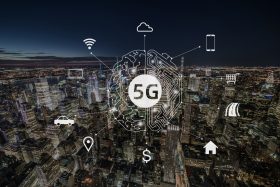Inside Cisco's Confusing Internet Market Report

If Cisco (Nasdaq: CSCO) is right, its business should be back to booming by 2023. That’s when the “bit of a pause” among enterprise decision-makers cited by CEO Chuck Robbins in last week’s earnings report should be resolved. That’s when the predictions in its recently released Cisco Annual Internet Report Forecast will be fulfilled.
Cisco has obviously put a lot of work into this report, which has become an annual marketing event, but it could have used more time finessing. So if you're like me, you can expect to put a lot of work into reading it — though Cisco’s tried to simplify things with an entire Webpage of tools and talking heads. Still, I was stymied from the start by the sheer tangle of facts, figures, and bullet points.
Here are a few examples:
“The number of devices connected to IP networks will be more than three times the global population by 2023. [Emphasis added.] There will be 3.6 networked devices per capita by 2023, up from 2.4 networked devices per capita in 2018.”
First of all, I was confused by what Cisco means by IP in a world moving away from traditional IP networking. But suspending disbelief, I assumed that the per capita figure refers to what the report describes as the “third of the global population [that] will have Internet access by 2023.” Cisco says that’s 5.3 billion users by 2023 (although the world’s population is now roughly 7.8 billion, and flat growth is predicted, so the future figure is unclear). Still, if I multiply 5.3 billion users by 3.6 per capita devices, I get 19 billion devices.
But then there's this Cisco factoid:
“There will be 29.3 billion networked devices by 2023, up from 18.4 billion in 2018.”
Ugh. Back to the calculator.
Mobility Matters
While only one-third of the global population will have Internet access in 2023, Cisco says that over 70% of the global population will have mobile connectivity in 2023.
So Cisco distinguishes Internet users from mobile users, then provides a hefty chunk of forecasting about all kinds of networking, from fixed broadband through WiFi, from 2G through 5G, with pricing estimates and regional breakouts. If you feel your head might explode, as I did, just remember one word: billions. Billions and billions. By 2023.
The IoT Market
The Internet of Things (IoT) market looms large in Cisco’s report. In the company’s press release about the report, I was intrigued by the following item:
“Machine-to-machine (M2M) connections that support a broad range of IoT applications will represent about 50% (14.7 billion) of total global devices and connections [by 2023].
Perusing the M2M forecast in the report for clarification, I quickly ran aground on statements like the following:
“Connected home applications, such as home automation, home security and video surveillance, connected white goods, and tracking applications, will represent 48 percent, or nearly half, of the total M2M connections by 2023.”
White goods? I had to look it up — fridges, washing machines, other appliances that usually come in white — or stainless steel, or black. And what is a tracking application? Maybe it has to do with microchipped pets?
The report throws smart home M2M in with verticals like energy and connected cities, as well as manufacturing and something called connected work, without regard to any possible overlap. So much information, so little clarity.
Dense for the Dense
Cisco’s Internet market summation dazzles with a density of figures that's difficult to parse. But one thing is clear: Cisco may be struggling with its mission(s), but it is still intent on supporting its networking products, with special emphasis on mobility and emerging broadband technologies.
Deep in the jumble of buzzwords, fancy numbers, and sometimes puzzling charts, I found the following gem that may be the key point of it all:
“[H]alf of all workloads will be run outside the enterprise data center by 2021, either in cloud/non-cloud data centers or at the network edge. Low- latency real-time communications and high-definition video applications will leverage the multi-access edge enabled by 5G and Wi-Fi 6.”
So there you have it, buried under a mountain of dullness dressed to impress — the Cisco hardware at the network edge, perhaps loaded with Cisco’s Silicon One chips, equipped with various enhancements and add-ons to adapt to ongoing digital transformation. All while addressing Cisco’s investment in enterprise and service provider backbone IP networks.
It’s a strategy that has been presented much more clearly and skillfully elsewhere. And if Cisco hopes to grab its share of half the global workloads by 2023, it should give its users more insight and intelligence than is offered in this report.





